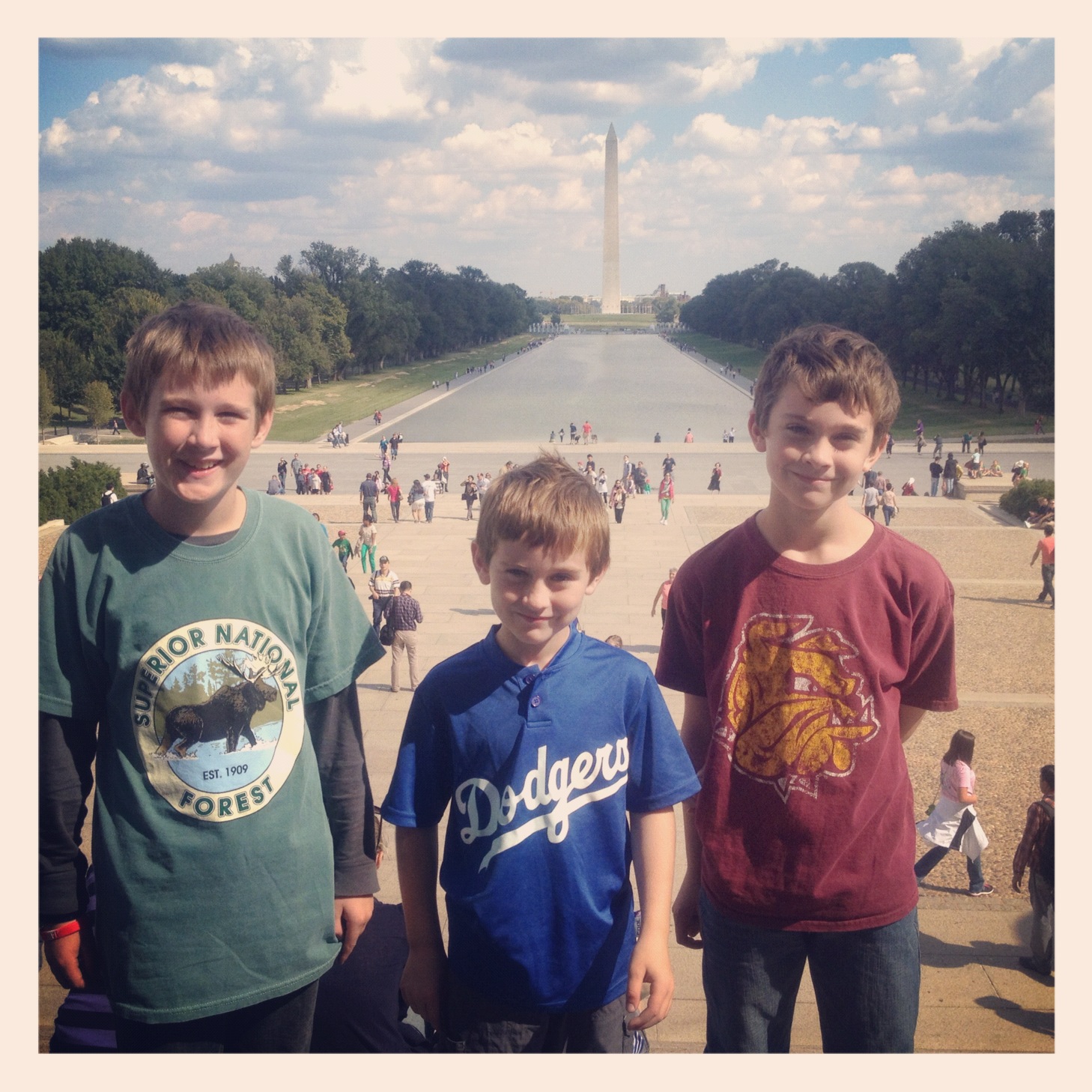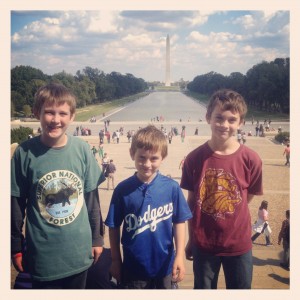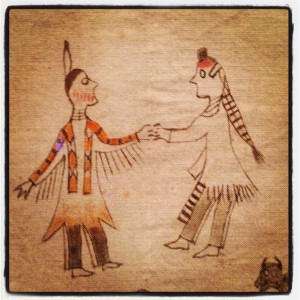Published in Mpls/St. Paul magazine, January 2013
Heart palpitations, dizziness, and sudden existential crises are a few of the symptoms of “Stendahl syndrome,” a psychosomatic illness seen in tourists exposed to extreme doses of artistic masterpieces, world history and high culture.
Though the official diagnosis is generally confined to Florence, Italy, the complaint could well have an American cousin: Smithsonian syndrome. You see sufferers all across the National Mall, foot-sore field trippers and families, bickering and breathing through their mouths, despairing at ever notching the many national treasures that no longer look quite as close together as they did on the map.
Our own three boys were starting to succumb as we stood in the entrance of the Smithsonian Museum of American History one election season weekend wondering what we were supposed to see next— Jackie Kennedy’s inaugural gown, George Washington’s telescope, Muhammad Ali’s “Rumble in the Jungle” robe, or the embattled flag that inspired Francis Scott Key to write the national anthem?
“I don’t want to see any more,” the middle kid protested, slumping to the ground in passive resistance. “There’s too many things here,” the youngest agreed, rubbing his eyes.
Since touching down inside the Beltway, we’d visited the giant pandas at the National Zoo, the changing of the guard at Arlington Cemetery, the White House, the Hope Diamond, Ford’s Theater, forty odd memorials and a giant foam snake named “Titanoboa.” So to cure their bellyaching, we decided it was time to cut the American pie into more manageable bites—a sampler of sites every card-carrying Minnesotan should see in D.C. If you’re headed there for this month’s inaugural—or just taking advantage of the surprisingly cheap fares this winter—this North Star State itinerary might work for you, too. There’s no place like home, right?
In fact, as long as we’re in the American History museum, let’s make tracks toward the Ruby Slippers Judy Garland—a.k.a Frances Ethel Gumm of Grand Rapids–wore in “The Wizard of Oz.” Designers made several pairs for Dorothy Gale (departing from the silver slippers described in Baum’s book), but the wear and tear on these size five’s suggests they were probably worn in dance scenes, skipping down the yellow brick road. A recent restoration has renewed the slippers’ magical properties—in October they even disapparated for a six-week visit to London’s Victoria & Albert Museum. 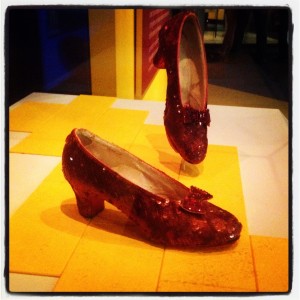
If you want to dig deeper, you could go find the sport coat Ted Baxter wore in “The Mary Tyler Moore Show,” but since he was only a fictional Minnesotan, you could just move along to the Air and Space Museum.
This is the landing place of the original Spirit of St. Louis, the custom-built monoplane Little Falls’ aviator Charles Lindbergh flew solo across the Atlantic. Upstairs you’ll also find the Lockheed Sirius Tingmissartoq he and his wife flew from North Haven, Maine, to Nanking—the first flight from east to west via a polar route. The exhibit gives Anne Morrow Lindbergh her due as a true pioneer in aviation who deserved the admiration of her peers not just for her gorgeous prose style but for her lightning fast Morse code.
A Greenland Eskimo gave the Lindbergh’s plane its name, which means “one who flies like a big bird,” and you’ll find more examples of Inuit poetry throughout the Museum of the American Indian. If you’re there before January 7, don’t miss “A Song for the Horse Nation,” a critically –acclaimed touring exhibit that explores how the horse changed the lives of the Native people, with some beautiful examples of Lakota ledgerbooks and tipis from the Great Plains. The naturalistic and curving walls of the museum are clad in Kasota dolomitic limestone from Minnesota—a warm and welcome relief from the cold, granite slabs that dominate most of the National Mall.
Now, if you’ve called ahead, you can stop in at the Capitol to visit your elected representatives: Senator Al Franken serves up a wild rice porridge to Minnesota visitors most Wednesdays the Senate is in session, while Senator Amy Klobuchar serves coffee and Potica, a Slovenian pastry perfected on the Iron Range, on Monday mornings.
But if you already had your Continental Breakfast, continue on to the Supreme Court, home office to notable Minnesota justices Pierce Butler, Harry Blackmun, and Warren Burger, and designed by Cass Gilbert, the St. Paul-bred architect who cut his teeth on our State Capitol. Some critics say this neo-classical marble confection was Gilbert’s great masterpiece, though the justices of day derided their new digs as an “almost bombastically pretentious” Temple of Karnak. The criticism may have stemmed from the fact Gilbert called on his friend Benito Mussolini to help him source some of the Siena marble he insisted on having for his columns, and also immortalized himself in one of the friezes. On the western pediment, just above the “Equal Justice Under Law” inscription, Gilbert is supposed to be the guy on the far left.
If you’re into architecture, then move along to the Old Patent Office, a city-block sized Greek Revival beautifully restored in 2006 to house both the National Portrait Gallery and the Smithsonian American Art Museum. You could spend a week here, but for the purposes of this tour, go see David Silvett’s portrait of F. Scott Fitzgerald, Jo Davidson’s bust of Sinclair Lewis and the photo of Hubert Humphrey looking on as L.B.J. signed the Civil Rights Act.
That great moment in American history owes everything to Martin Luther King’s “I Have a Dream” speech, delivered from the 18th step of the Lincoln Memorial—everyone’s favorite monument, judging by the field trip students, foreign tourists and Harley riders who take patient turns taking snap shots at the feet of the Great Emancipator. Abraham Lincoln was the first presidential candidate the new state of Minnesota elected to office in 1860, and Minnesota was one of the first to answer his call for 75,000 volunteer troops at the start of the Civil War.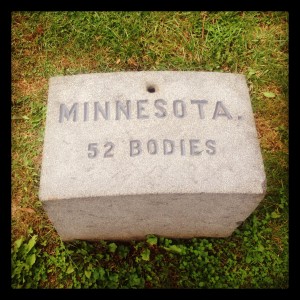
The volunteers of the First Minnesota went on to fight at First Bull Run, Antietam, and most famously on July 2, 1863– the second day of the Battle of Gettysburg. It takes less than two hours to drive from D.C. to the Gettyburg National Military Park and stand at the monument marking the ground on Cemetery Ridge where 262 volunteers from the First Minnesota charged into the Alabama Brigade. It was “a contest so unequal” recalled the Confederate officer, that his troops outnumbered the Minnesotans nearly five to one. Only 47 men survived the charge, enough to hold the Union line and to become what President Calvin Coolidge later called “the saviors of our country.”
We took the long way back to D.C. that day, crossing the Mason-Dixon line, passing scores of presidential lawn signs that punched right, then left. If the race for the White House left you weary, a weekend in Washington might be the medicine you need, too. At the very least, it offers historic reassurance that the American dream can survive much worse than an election year.
If you go:
Want to tour the White House?: Contact your member of Congress to request a self-guided tour up to six months and usually no less than 21 days before your planned visit. Most congressional websites can also help you secure tickets to see the Capitol, State Department, Supreme Court, the Pentagon, and other federal landmarks.
Fly for less: With three airports that serve greater D.C., competitive fares make flying surprisingly budget-friendly for family trips. (In fact, we paid only $198 for round-trip tickets to Baltimore Washington International.) If you can plan ahead and don’t need to be there for cherry blossom season, you can easily find round trips for under $300.
There’s an app for that: D.C. is also well served by smartphone developers, though there are just a few apps we found essential: NPS National Mall, Smithsonian Mobile, and DC Metro Map.
Day trips: Gettysburg National Battlefield is about 90 minutes from D.C., but if you’re going to rent a car consider a side-trip to Mount Vernon, Colonial Williamsburg or Shenandoah National Park—all within two and a half hours of the Beltway.

